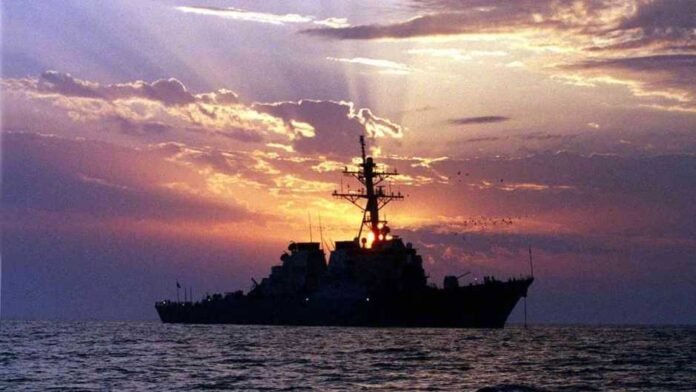The Red Sea, a geopolitical hotspot, has recently witnessed a surge in tensions with Houthi rebels claiming responsibility for attacks on commercial ships. This article delves into the unfolding events and the U.S. warship’s strategic response, exploring the intricacies of maritime security and the broader implications for global stability.
1. U.S. Warship Responds to Houthi-Claimed Attacks Introduction
A. Brief Overview of the Situation
In the vast expanse of international waters, the Red Sea has become a focal point of contention. Recent events have thrust this region into the spotlight, demanding a closer examination of the complex dynamics at play.
B. Significance of the Red Sea Region
Beyond its azure waters, the Red Sea holds immense strategic importance, serving as a critical maritime artery for global trade. Understanding the nuances of the geopolitical landscape is crucial in deciphering the implications of recent developments.
2. Houthi-Claimed Attacks: Unraveling the Narrative
A. Houthi Allegations and Targets
Houthi rebels allege targeting commercial ships, raising questions about the motives behind such actions. Scrutinizing the specific vessels affected and the nature of the attacks provides insight into the evolving narrative.
B. Assessing the Credibility of Houthi Claims
As international stakeholders assess the veracity of Houthi statements, a closer examination of past claims and their outcomes is imperative. Distinguishing fact from rhetoric is a key step in formulating an informed perspective on the situation.
3. Escalation in the Red Sea
A. Timeline of Recent Incidents
A chronological overview of recent incidents contextualizes the escalation in the Red Sea. Examining the sequence of events sheds light on the evolving dynamics and the triggers that led to the U.S. warship’s deployment.
B. Impact on Global Trade Routes
Beyond the regional implications, disruptions in the Red Sea have a cascading effect on global trade routes. An analysis of the economic repercussions underscores the interconnectedness of maritime security and the world economy.
4. U.S. Naval Presence: A Swift Response
A. Deploying the U.S. Warship
The decision to dispatch a U.S. warship reflects a commitment to safeguarding maritime interests. Exploring the rationale behind this deployment provides insights into the U.S. military’s strategic calculus in the region.
B. The Strategic Importance of the Red Sea for the U.S.
Beyond the immediate response, understanding why the U.S. considers the Red Sea a vital area of interest elucidates the broader geopolitical chessboard and the stakes involved.
5. International Reaction and Concerns
A. Response from Allies and Partners
As the international community reacts to the unfolding situation, examining the responses of key allies and partners provides a panoramic view of the diplomatic landscape. The alliances formed or strained in the wake of these events have far-reaching implications.
B. Broader Implications for Regional Stability
The ripple effects of the Red Sea tensions extend beyond maritime security. Delving into the potential impact on regional stability sheds light on the interconnected nature of geopolitical events.
6. Maritime Security: Challenges and Solutions
A. The Complexity of Securing International Waters
Securing vast expanses of international waters is no easy feat. Unpacking the challenges inherent in maritime security helps contextualize the difficulties faced by navies in safeguarding these vital waterways.
B. Collaborative Efforts to Ensure Maritime Safety
Exploring collaborative approaches to maritime security provides a glimmer of hope amidst the turbulent waters. International cooperation and initiatives aimed at ensuring the safety of commercial shipping lanes are integral to finding sustainable solutions.
7. Houthi Strategies: Unpacking the Motivations
A. Examining Houthi Objectives in the Red Sea
A deeper dive into Houthi objectives in the Red Sea unravels the geopolitical motivations that underpin their actions. Understanding the strategic goals of the rebels enriches the analysis of the ongoing crisis.
B. Historical Context and Geopolitical Motivations
Placing recent events in a historical context reveals enduring geopolitical motivations shaping the Red Sea narrative. An exploration of historical antecedents provides a nuanced understanding of the complexities at play.
8. The U.S. Military’s Rules of Engagement
A. Legal and Ethical Considerations
The U.S. military’s response operates within a framework of legal and ethical considerations. Examining the rules of engagement sheds light on the delicate balance between asserting military presence and adhering to international norms.
B. Balancing Deterrence with De-escalation
In a region fraught with tension, the challenge lies in balancing deterrence with de-escalation. Analyzing the U.S. military’s approach to maintaining stability provides insights into the delicate dance of power in international waters.
9. Future Scenarios: Navigating the Uncharted Waters
A. Potential Developments in the Red Sea
As the situation unfolds, considering potential future developments is essential. Scenario analysis helps policymakers and analysts anticipate challenges, enabling proactive measures to safeguard regional and global interests.
B. Contingency Planning and Diplomatic Initiatives
Navigating uncharted waters necessitates robust contingency planning and diplomatic initiatives. Examining the role of diplomacy in defusing tensions and fostering long-term stability underscores the importance of multifaceted approaches.
10. Conclusion
A. Recapitulation of Key Points
Summarizing the key takeaways from the article reinforces the critical aspects of the Red Sea crisis and its implications.
B. The Broader Implications for Global Security
In conclusion, the article reflects on how the events in the Red Sea resonate on the global stage, emphasizing the interconnectedness of maritime security with broader geopolitical and security concerns.


